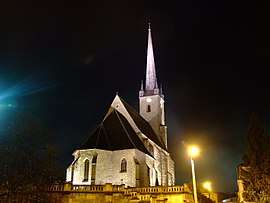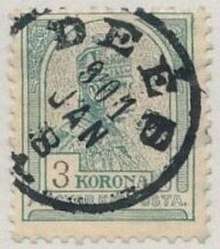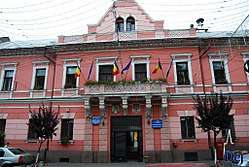Dej
Dej (Romanian pronunciation: [deʒ]; Hungarian: Dés; German: Desch, Burglos; Yiddish: דעעש Desh) is a municipality in Transylvania, Romania, 60 km (40 miles) north of Cluj-Napoca, in Cluj County. It lies where the river Someșul Mic meets the river Someșul Mare. The city administers four villages: Ocna Dejului (Désakna), Peștera (Pestes), Pintic (Oláhpéntek) and Șomcutu Mic (Kissomkút).
Dej | |
|---|---|
 Dej Calvinist Church | |
 Coat of arms | |
 Location in Cluj County | |
 Dej Location in Romania | |
| Coordinates: 47°05′14″N 23°48′19″E | |
| Country | |
| County | Cluj |
| Government | |
| • Mayor | Costan Morar[1] (PSD) |
| Area | 109.12 km2 (42.13 sq mi) |
| Population (2011)[2] | 33,497 |
| • Density | 310/km2 (800/sq mi) |
| Time zone | EET/EEST (UTC+2/+3) |
| Vehicle reg. | CJ |
| Website | www |
The city lies at the crossroads of important railroads and highways linking it to Cluj-Napoca, Baia Mare, Satu Mare, Deda, Bistrița, and Vatra Dornei.
History

Like the rest of the territory of Cluj County, Dej was part of Hungary prior to 1920. The city was first mentioned in 1214 as Dees, in 1236 as Deeswar, in 1310 as Deesvitta, in 1351 both Deés[3] and Deésvár occurred, the earlier has been used until eventually it was changed to Dés. It had a royal charter as a free city and was the capital of Szolnok-Doboka County.[3] In 1905 it had a protestant church from the 15th Century, and a tower from 16th Century fortifications.[3] It was primarily a market town for local wines and other agricultural products.[4]
Demographics
| Historical population | ||
|---|---|---|
| Year | Pop. | ±% |
| 1910 | 11,452 | — |
| 1930 | 15,110 | +31.9% |
| 1948 | 14,681 | −2.8% |
| 1956 | 19,281 | +31.3% |
| 1966 | 26,984 | +40.0% |
| 1977 | 32,345 | +19.9% |
| 1992 | 41,216 | +27.4% |
| 2002 | 38,478 | −6.6% |
| 2011 | 33,497 | −12.9% |
| Source: Census data | ||
According to the 2011 Romanian census, there were 33,497 people living within the city.
Of this population, 81.8% are ethnic Romanians, while 11.3% are ethnic Hungarians, 1.0% Roma and 0.1% others.[5]
Natives
Gallery
 Dej in 1902
Dej in 1902 The City Hall
The City Hall City Square at Night
City Square at Night Avram Iancu Street
Avram Iancu Street Synagogue in Dej
Synagogue in Dej Pentecostal Temple in Dej
Pentecostal Temple in Dej The Roman Catholic Church
The Roman Catholic Church Greek-Catholic Church in 1 Mai
Greek-Catholic Church in 1 Mai Andrei Muresanu National College
Andrei Muresanu National College Graves in the Jewish cemetery of Dej
Graves in the Jewish cemetery of Dej
References
- "Results of the 2016 local elections". Central Electoral Bureau. Retrieved 3 April 2020.
- "Populaţia stabilă pe judeţe, municipii, oraşe şi localităti componenete la RPL_2011" (in Romanian). National Institute of Statistics. Retrieved 4 February 2014.
- "Deés". Austria-Hungary: Including Dalmatia and Bosnia; Handbook for Travellers. Karl Baedeker. 1905. p. 406.
- Ritter, Carl (1874). "Deés". Geographisch-statistisches Lexikon über die Erdteile, Länder, Meere, Buchten, Häfen, Seen, Flüsse, Inseln, Gebirge, Staaten, Städte, Flecken, Dörfer, Weiler, Bäder, Bergwerke, Kanäle etc (in German). Wigand. p. 375.
- Tab8. Populaţia stabilă după etnie – judeţe, municipii, oraşe, comune, 2011 census results, Institutul Național de Statistică, accessed 17 February 2020.
External links
| Wikimedia Commons has media related to Dej. |
